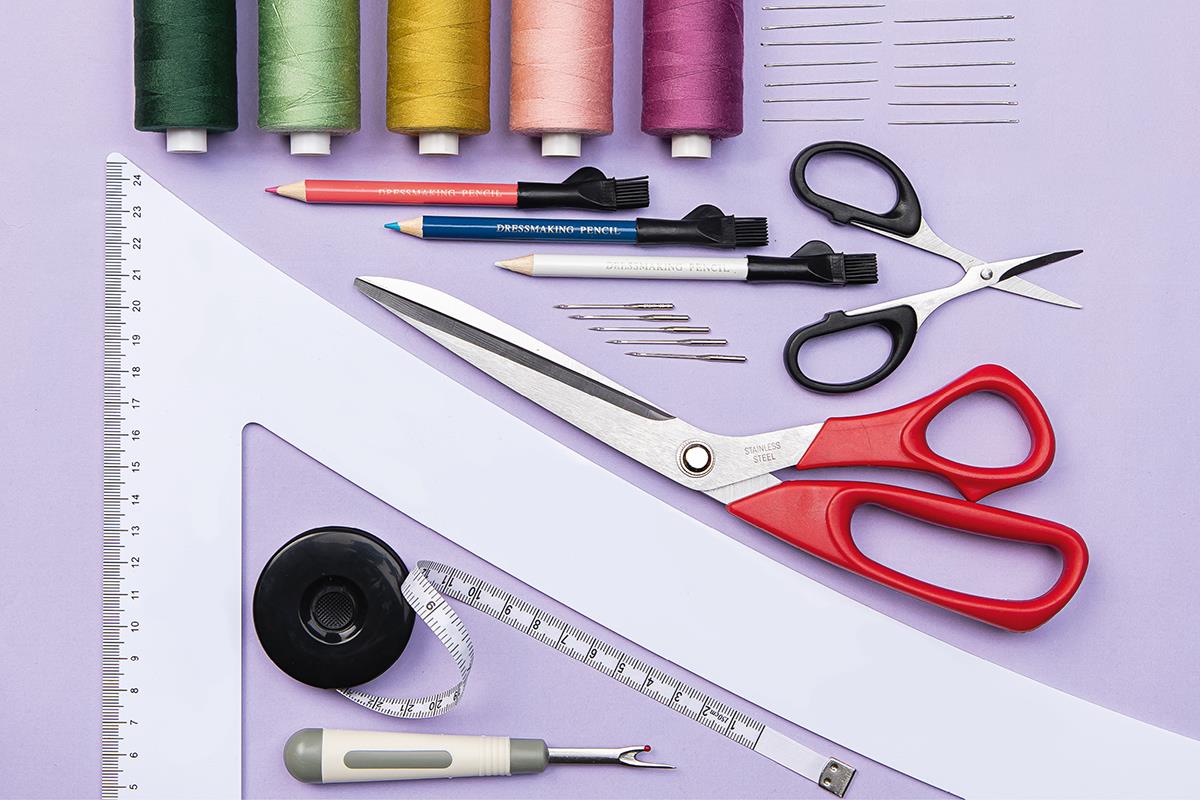

Compile a starter-kit
Before you start, make sure you have all the necessary equipment. Selfmade® has everything you need:
1. Tailor’s chalk
Use tailor’s chalk to draw up your pattern pieces before cutting — and to mark darts, notches, and other pattern markings.
2. Small needlework scissors
Fine embroidery scissors are good to have at hand for trimming loose thread ends as you sew.
3. The right needles
Even though you might machine-sew most things, a sharp hand-sewing needle is still a must. Not every little detail can be reached on your machine and you sometimes need to rely on manual labour.
4. Thread
Always buy premium quality thread. Trust us when we say that there are few things more annoying than thread breaking in the middle of a tricky corner. For your starter kit, all-purpose polyester thread is your go-to, does-it-all-thread.
5. Tape measure
A must-have in every sewing kit. You’ll need it for body measurements and measuring out your fabric.
6. Fabric shears
Sharp scissors are a true must-have in your sewing kit, as sharp fabric shears prevent fraying. Do not use your scissors for anything other than fabric, because this blunts the blades.
7. Seam ripper
This handy tool is another key part of your sewing starter kit. Every designer makes a mistake now and then. A good seam ripper allows you to rip up a seam and correct your mistake.
8. Tailor’s ruler
This broad ruler is much easier to use than a straight ruler you might find in your office suppliers. The broad surface keeps your fabrics straightened while you work.
9. Sewing machine needles
Whether you hand-sew or use your sewing machine, a sharp needle is a must. Different fabrics require different needles, and using the wrong needle could damage your fabric. Make sure you use the right needle for the job.
10. Pins
They keep your pattern in check and keep your seams in place. Glass-head pins are easy to pick off as you sew.
Find yourself a good beginner's machine
Your starter kit is not complete without a proper sewing machine. You won't need a hyper-advanced machine with all sorts of gadgets and gizmos - a decent beginner's machine with the most used stitches and functions will get you going.
If you can, test different models before you buy, and get the machine that fits you best. You can always upgrade to a more advanced model later.
Learn to use paper patterns
As a sewing novice, you need to take care not to bite off more than you can chew. Start with easier projects and avoid getting frustrated and quitting halfway through.
Start with easy patterns
To make things easier for you, we have divided our patterns into three difficulty levels. EASY, INTERMEDIATE, ADVANCED, and EXPERT. Start with the EASY patterns and get used to your machine, and different types of fabric and accessories.
Learn your sewing gobbledegook
Allow yourself time to thoroughly read the sewing instructions. This helps you keep track of the sequence in which you need to sew the different pattern pieces, and teaches you a thing or two about sewing jargon.
Numbering your pattern pieces helps you to keep track of them.
Test your different fabrics
Try our different types of fabrics - each fabric has specific properties you need to keep in mind. Finely woven cotton requires a different approach than knitted fabrics. Stretch fabrics can be trickier to handle than cotton canvas.
Cut off a small piece of every new fabric and use it to get to know the fabric, the required stitches and the way it drapes.
Take your time
Promise that you will take your time when you are sewing. Sewing takes time – and that’s the great thing about it.
You can immerse yourself in your thoughts, wallow in creative flow and live in the moment. A perfect moment of creative zen, if you will.
Perfectly imperfect
Your first projects will likely be far from perfect. That is too much to expect. Be patient. Tell yourself that you will learn from your mistakes – and that you will learn something new every time you use your sewing machine.
All big ideas have humble beginnings, and practice makes perfect. It may sound cliché, but it does hold true for sewing. And for many other things, for that matter.
Keep trying, and your sewing skills will improve day by day.